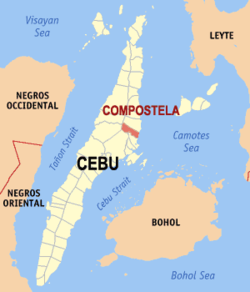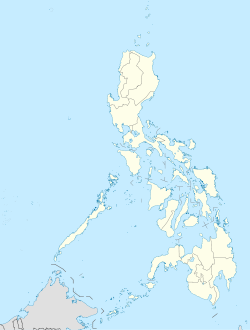- Compostela, Cebu
-
Compostela — Municipality — 
SealNickname(s): Land of the Free Map of Cebu showing the location of Compostela. Location in the Philippines Coordinates: 10°27′0″N 124°0′0″E / 10.45°N 124°ECoordinates: 10°27′0″N 124°0′0″E / 10.45°N 124°E Country  Philippines
PhilippinesRegion Central Visayas (Region VII) Province Cebu District 5th district of Cebu Founded December 26, 1878 Barangays 17 Government - Mayor Ritchie Reyes Wagas Area - Total 53.9 km2 (20.8 sq mi) Population (2007) - Total 39,167 - Density 726.7/km2 (1,882/sq mi) Time zone PST (UTC+8) ZIP code 6003 Dialing code 032 Income class 5th class; partially urban Website elgu.ncc.gov.ph Compostela is a 4th class municipality in the province of Cebu, Philippines. According to the 2007 census, it has a population of 39,167.
Compostela is part of a metropolitan area informally called as Metro Cebu.
Contents
History
In the year 1844, a Spanish captain by the name of Manuel Aniceto del Rosario was commissioned by the higher Spanish authorities to establish local government units on the northern part of Cebu starting from what is now known as the town of Compostela as far north as what is presently called the town of Borbon. Compostela was among the early barrios of the Municipality of Danao established by Captain del Rosario. The newly establish barrio was named Compostela upon the suggestion of Father Jose Alonzo, a Roman Catholic friar who, by some historical account, reportedly came from the town of Compostela in Spain and brought along with him the image of the town’s patron saint, Senor Santiago de Apostol, Subsequently thereafter, Father Alonzo was designated as the first parish priest of the newly established barrio of Compostela. Adopting Senor Santiago de Apostol as the parish patron saint, Father Alonzo spearheaded the construction of the parish chapel out of light materials. As the population grew, the Spanish church authorities decided to elevate the chapel into a church so that in the year 1866 the Roman Catholic Church was constructed in the same site replacing the old chapel. Since then up to the present time, the same structure continues to be the major place of worship among the Catholic faithfuls in Compostela.
The Early leaders who served as barrio capitanes of Compostela were as follows: Juan Gesulga, Intoy Terrado, Carlos Perales, Felix Kanen, Severino Calo, Arcadio Bantilan, Segundo Gesulga, Bonifacio Librero, Lorenzo Castro, Gregorio Kanen and Mario Castro.At the turn of the 20th Century, the Americans gained control over the Philippines when they defeated the Spaniards in the Battled of Manila Bay. As a consequence, the Treaty of Parish facilitated the reorganization and reclassification of all local government units in the country in accordance with their population and income. The actual reorganization which took place in 1903 resulted in the secession of Compostela to the Municipality of Liloan. In the year 1918, Compostela was finally considered to be converted into a municipality when a special committee headed by Hilario Kanen, thru Cebu Provincial Governor Manuel Roa, made representations to Hon. Sergio Osmena Sr., Speaker of the Philippine Assembly, to sponsor a bill creating the Municipality of Compostela. A year later, on that fateful 17th day of January 1919, Compostela officially became a municipality.
When the Japanese Imperial forces was occupied and entered the towns in Compostela, Cebu in 1942.
Battle of Guila-Guila Part of World War II Date March 05, 1943 Location Guila-Guila, Compostela, Cebu Result Filipino Victory Belligerents  Philippine Commonwealth
Philippine Commonwealth
* Philippine Commonwealth Army
Philippine Commonwealth Army
* Various Local Recognized Guerrilla Unit
Various Local Recognized Guerrilla Unit Empire of Japan
Empire of Japan
* Imperial Japanese Army
Imperial Japanese ArmyStrength 80,000 Filipino troops
14,400 Cebuano Guerrillas210,000 Japanese troops Casualties and losses Filipino troops
600 killed
1,832 wounded
Cebuano guerrillas
244 killed
1,670 woundedJapanese troops
2,610 killed
8,533 wounded
3,400 capturedDuring the Battle of Guila-Guila on March 5, 1943, guerillas and male civilians organized as the soldiers and officers of the 8th Infantry Division of the Philippine Commonwealth Army and its subordinate units the several Infantry Regiments, Field Artillery Regiments and many others and supporting of the local troops and officers of the PCA 3rd, 8th, 82nd, 85th, 86th and 87th Infantry Division and the local Cebuano resistance groups fought the Japanese. This battle, commanded by Major Fabian M. Sanchez, resulted in numerous casualties to the Imperial Japanese Army led by General Sosaku Suzuki and conservative estimates were ten (10) truckloads of dead Japanese soldiers observed being carted away after the battle versus one (1) Filipino killed.
Liberation of Compostela Part of World War II Date 1945 Location Compostela, Cebu Result Allied Victory Belligerents  Philippine Commonwealth
Philippine Commonwealth
* Philippine Commonwealth Army
Philippine Commonwealth Army
* Philippine Constabulary
Philippine Constabulary
* Various Local Recognized Guerrilla Unit
Various Local Recognized Guerrilla Unit
 United States
United States
* United States Army
United States Army
* United States Navy
United States Navy
* United States Army Air Force
United States Army Air Force Empire of Japan
Empire of Japan
* Imperial Japanese Army
Imperial Japanese ArmyStrength 245,000 Filipino troops
16,000 Cebuano Guerrillas
25,000 American troops190,000 Japanese troops Casualties and losses Filipino troops
4,120 killed
16,500 wounded
Cebuano guerrillas
700 killed
2,750 wounded
American troops
879 killed
1,800 woundedJapanese troops
30,000 killed
80,000 wounded
12,000 capturedDuring the Allied Liberation in 1945 after the Battle of Guila-Guila in 1943 from the successful Filipino soldiers and Cebuano guerrilla fighters. The U.S. Liberation forces was came back and liberated the towns in Compostela, Cebu and helping the stronghold Filipino soldiers of the 3rd, 8th, 82nd, 85th, 86th and 87th Infantry Division of the Philippine Commonwealth Army and the 8th Infantry Regiment of the Philippine Constabulary included the Cebuano guerrilla fighters and defeats Japanese Imperial forces and ended in World War II.
Barangays
Compostela is administratively subdivided into 17 barangays.
- Bagalnga
- Basak
- Buluang
- Cabadiangan
- Cambayog
- Canamucan
- Cogon
- Dapdap
- Estaca
- Lupa
- Magay
- Mulao
- Panangban
- Poblacion
- Tag-ubi
- Tamiao
- Tubigan
Councilors
See also
External links
- Official Website of Compostela, Cebu
- Philippine Standard Geographic Code
- 2007 Philippine Census Information
Cities Municipalities Component local government units of Cebu Municipalities Alcantara • Alcoy • Alegria • Aloguinsan • Argao • Asturias • Badian • Balamban • Bantayan • Barili • Boljoon • Borbon • Carmen • Catmon • Compostela • Consolacion • Cordova • Daanbantayan • Dalaguete • Dumanjug • Ginatilan • Liloan • Madridejos • Malabuyoc • Medellin • Minglanilla • Moalboal • Oslob • Pilar • Pinamungahan • Poro • Ronda • Samboan • San Fernando • San Francisco • San Remigio • Santa Fe • Santander • Sibonga • Sogod • Tabogon • Tabuelan • Tuburan • TudelaComponent cities Highly urbanized cities (Administratively independent from the province, but grouped under Cebu by the National Statistics Office)Categories:- Municipalities of Cebu
Wikimedia Foundation. 2010.


